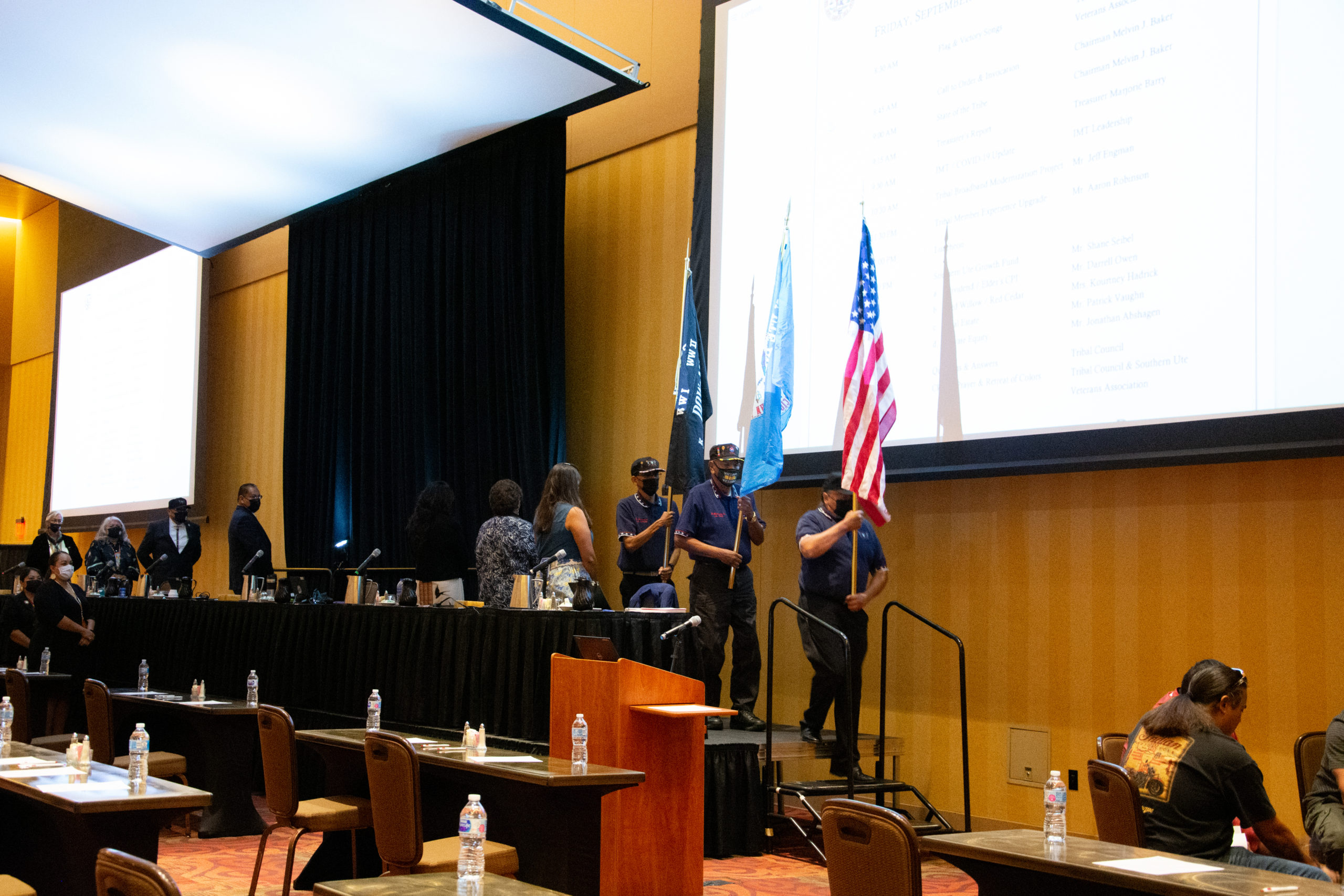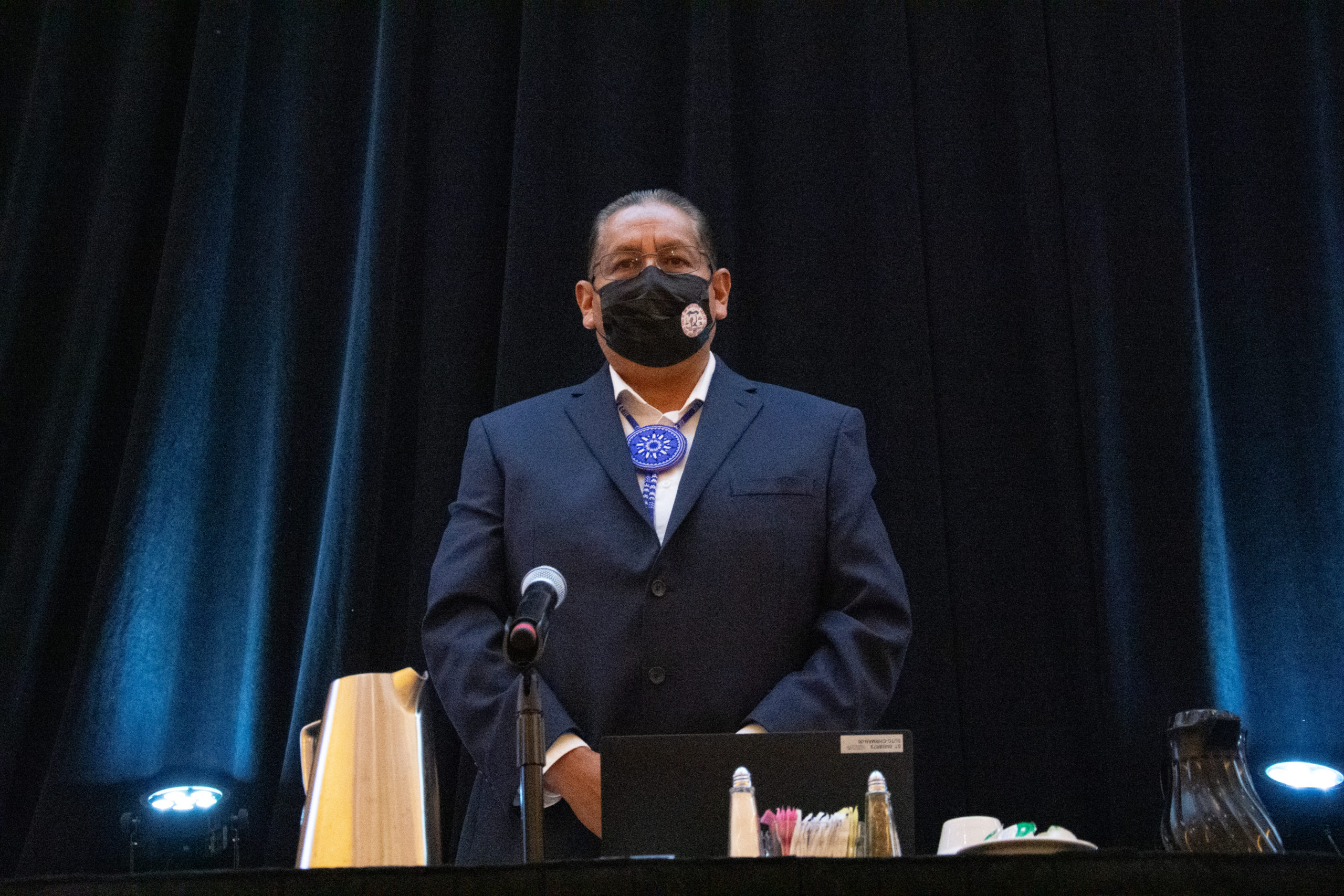The Southern Ute Indian Tribe held its first General Meeting in over two years at the Sky Ute Casino Resort Events Center on Friday, Sept. 17. This is one of the first in person events that the Southern Ute Tribal Council has hosted for its membership since the start of the pandemic in early 2020.
“It has not been easy, but we have gotten through it,” stated Chairman Melvin Baker during his introduction. “We had to look out for the safety of our tribal members.”
Since the start of the COVID-19 Pandemic in March of 2020, the Southern Ute Tribe has taken a vigilant approach to ensure the spread of infection of COVID-19, and the recent Delta Variant, was slowed with as minimal impact on the tribal membership as possible. This resulted in a hybrid event that allowed the membership to attend both the socially distanced and masked up in-person option or by way of an online WebEx event. Both versions of the General Meeting allowed those in attendance to get information on the current state of the Southern Ute Tribe, while also asking any questions or raising concerns to Tribal Council and presenters in attendance.
The main topics that were discussed during the meeting included the Tribal Council Treasurer’s Financial Report, the Incident Management Team Update, an introduction to the Broadband Modernization project and Tribal Member Portal Upgrade, and the Growth Fund Report.
“I am proud to stand here and reassure you that the Tribe remains strong and stable at a time where there is so many unknowns,” Chairman Baker stated.
The Chairman’s Report
Chairman Baker started the event with the annual Chairman’s Report. This report gave tribal members a glimpse of the current state of the Tribe, as well as introducing the current short-term focus and long-term goals of the current administration through the inception of Tribal Council’s 13 Priorities. Each of the 13 Priorities were introduced and approved this past spring by Tribal Council.
Each of the 13 Priorities gives heavy focus on issues that surround the Southern Ute Tribe as a whole, its tribal members and the reservation boundary. Some of the 13 Priorities are COVID-19, Broadband Internet access, water revitalization and protection, language revitalization, updating Tribal Codes and Ordinances, strategic planning, among a variety of other key topics. Tribal Council did emphasize these priorities do not have a specified deadline for when they will be completed, as some may take years to fully complete or accomplish. For example, it is unknown what the lasting effects of the COVID-19 Pandemic are and there is the uncertainty of when it will end.
For now, Tribal Council will remain diligent in working on the 13 Priorities as they will continue to be a guide for the current administration for this year and years to come.
Incident Command Team Update
Along with the annual Chairman’s Report and introduction on effects of the COVID-19 Pandemic, the Incident Command Team (IMT) gave an update on their work from the previous year as well as their response to the COVID-19 Pandemic.
“[Our] number one priority is preservation of life,” stated Duty Incident Commander, Tyson Thompson. “We are doing our best to protect our lives [as a community].”
The IMT was established by a resolution on February 18, 2020, in response to the growing concerns of the COVID-19 Pandemic. By design, the IMT was created to be as flexible as possible to maintain the incident during the waves of the Pandemic, while still maintaining a structure created by the Federal Emergency Management Agency (FEMA) and the Southern Ute Tribe’s Core Values. The IMT also continues to follow the Center of Disease Control (CDC) Guidelines as well as state, and regional guidelines and are closely monitoring trends in our region. Tribal Council remains at the top of the team and gives guidance and approval as needed. Currently, about 22 tribal members work within IMT and have continued to work during the pandemic whenever or wherever they are needed.
The biggest challenge currently remains the dominant Delta Strain of COVID-19, which is more transmissible than the original strain seen in 2020.
IMT also reassured that all tribal offices are open, with most employees back in person with some employees working a hybrid model or from home depending on their deviation plans. IMT will continue to watch trends in the region and act accordingly, as the Tribe’s operational status and current phase of operations is based on statistics and numbers of infections.
“We really need to pay attention to the data trends in our area to keep people safe,” said IMT Public Information Officer, Amy Barry, in relation to the “Stay at Home” metric system. The IMT continues to urge tribal and community members to get tested and vaccinated and take preventative measures to slow the spread of the Delta variant and COVID-19.
Southern Ute Shared Services Update
Southern Ute Shared Services (SUSS) delivered pertinent information at the General Meeting by presenting in two separate time slots.
The first was a formal introduction and update on the Broadband Modernization Project. The Project was presented by Project Manager, Delbert Cuthair Jr. and SUSS Chief Information Officer, Jeff Engman. The project aims to provide high-speed internet to the reservation and to those specific areas where internet may not exist through primarily grant funding and funding from the Southern Ute Tribe.
According to Cuthair, 94% of internet users on the reservation do not meet the 25/3 per second speed (MBPS) and 86% do not have access to affordable high-speed internet. The COVID-19 Pandemic has highlighted a major need for updated internet infrastructure as more tribal and community members need the internet for work, school and telehealth visits.
Currently, the project is in the first initial phase, and hopes to provide 50/10 MBS internet by establishing two new towers and 52 miles of fiber optics cables to 50% of tribal homes, by November of 2022. The project hopes to be completed by 2026 with 95% of coverage in homes and introduce 100 MBPS internet to the reservation.
In a separate presentation, SUSS Vice President of Applications Development introduced the updated Tribal Member Portal and gave a formal demonstration on the updated look and available features. The updated portal aims to connect and help engage the membership by giving tribal members a platform to easily access important information from the Southern Ute Tribe and its entities. The updated platform was created to be as user friendly as possible by employing a system that has been created for the Permanent Fund and Growth Fund, yet customized based on the feedback and concerns of the membership.
The new portal can now be accessed via a mobile application and now includes “Yammer,” a site that replicates a social media like platform exclusively for tribal members to get information and alerts directly from Tribal Council and the Executive Office.
SUSS will continue to update the new Tribal Member Portal based on feedback it receives and will continue to make it a priority for any tribal member to receive the information they need right at their fingertips.
Southern Ute tribal members can sign up for the Tribal Member Portal via the Southern Ute Tribe’s Tribal Member Experience Help Center at www.southernute-nsn.gov/tmx.




